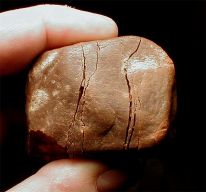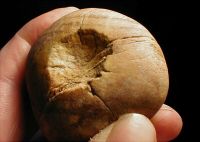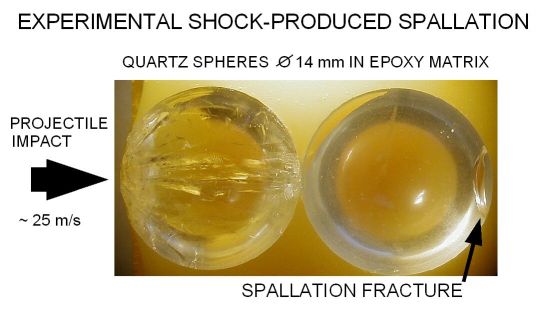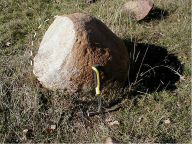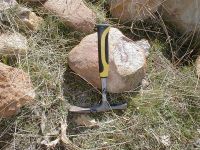| Spallation is a well-known process in fracture mechanics as well as in impact cratering and has been investigated theoretically and experimentally by many researchers. Unfortunately, it is less well known that spallation can also be observed in nature as an actually existing geologic phenomenon in and around impact structures. The present WEEKLY IMAGE shows already known spallation features in conglomerates around the Azuara/Rubielos de la Cérida impact structures (Spain), now recognized to form a 120 km long impact crater chain (see
– KLICK here; and Ernstson, K., Schüssler, U., Claudin, F. & Ernstson, T. (2003): An Impact Crater Chain in Northern Spain. – Meteorite, 9/3, 35-39 – KLICK here), and prominent spallation fractures only recently observed in ejecta (Pelarda Fm. ejecta) from this crater chain.Spallation takes place when a compressive shock pulse impinges on a free surface or boundary of material with reduced impedance (= the product of density and sound velocity) where it is reflected as a rarefaction pulse. The reflected tensile stresses lead to detachment of a spall or series of spalls.Prominent spallation effects have been reported for shocked Buntsandstein conglomerates exposed around the Azuara/Rubielos de la Cérida impact structures. Details about these geologic spallation features have been described in Ernstson, K., Rampino, M.R., and Hiltl, M. (2001): Cratered cobbles in Triassic Buntsandstein conglomerates in northeastern Spain: An indicator of shock deformation in the vicinity of large impacts. Geology, 29, 11-14., and can be found here. |
|
|
|
|
|
Images D, E. Concave spallation fracture surfaces in quartzite boulders from the Pelarda Fm. ejecta. |
|
| The Images A and B show typical shock-produced spallation features in these Buntsandstein quartzite cobbles: subparallel open spallation fractures (Image A) and a concave fracture surface forming a crater after the detachment of a lens-shaped spall (Image B). This concave spall fracture near a spherically shaped reflection surface is predicted by theory (and hardly explained by any other geologic process) and can be produced experimentally as shown in Image C. | |
| The shock experiments were performed at the Fraunhofer Institute for High-Speed Dynamics (Ernst-Mach-Institut) in Freiburg, Germany. A single-stage powder gun was used to accelerate steel projectiles. As targets, we used two quartz spheres (rock crystal) in contact, embedded in a synthetic epoxy matrix. The shots were performed with impact velocities in the range of 25 to 115 m/s, corresponding to initial impact pressures between 0.55 and 2.5 GPa (5.5 and 25 kbar). The recovered samples were cut in half (see Image C, shot 3), thin sections were made, and the results of our observations were presented in Ernstson, Rampino, and Hiltl (see above). Here, the recovered sample of shot 3 at lowest impact velocity is shown (Image C) displaying a clear spallation fracture in the right-hand sphere otherwise untouched. | |
| In the Ernstson/Rampino/Hiltl paper published by Geology (see above), the importance of such shock-deformed autochthonous conglomerates for an easy recognition of regional impact signature has been pointed out. | |
| Here, we report on recent observations of prominent spallation fractures in quartzite boulders from the Azuara/Rubielos de la Cérida impact ejecta (Pelarda Fm.). The Image D shows a typically deformed boulder that displays a concave spall fracture surface being a mirror image of the convex surface (sketched as white broken line in Image D) of the detached (and now missing) large spall. A similar concave spallation fracture can be seen in Image E. | |
| The quartzite boulders (mostly Cambrian Bámbola quartzite and Ordovician Armorican quartzite) contributed to the upper part (dominating molasse sediments) of the purely sedimentary target and, upon impact, experienced moderate to strong shock before excavation and ejection. The shock is documented by abundant multiple sets of PDFs in quartzite boulders (see, e.g., the sound PDF analysis made by Dr. Ann Therriault, in: Ernstson, K., Claudin, F., Schüssler, U. & Hradil, K. (2002): The mid-Tertiary Azuara and Rubielos de la Cérida paired impact structures (Spain). – Treb. Mus. Geol. Barcelona, 11, 5-65 – KLICK here, and on shockeffects ). We assume that the prominent spall fractures in the large quartzite boulders have originated also from the initial shock event, although a formation by collision of quartzite boulders during excavation and ejection must also be taken into consideration. | |
Ir al contenido
ERNSTSON CLAUDIN ESTRUCTURAS DE IMPACTO – CRÁTERES METEORÍTICOS
Investigación sobre la geología, geofísica, y petrología







































































